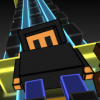I've had the rare privilege of being invited by Microsoft to participate in the worlds very first holographic hackathon this weekend. I thought I'd share a few quick notes and thoughts so far:
Mind blowing stuff:
-The hololens is able to recognize voice commands. You can say, "Cortana, record this." and it will start taking video feed recordings!
-It has NO wires. The thing is a mobile computer which is strapped to your head. Take a minute to think about that and let it sink in.
-You can use three hand gestures to create user input commands
-You can place holograms on top of tables and on walls. How freakin' cool is that?! This is done by 'spatializing surfaces'.
-The devices uses cameras and infrared lasers to visualize your environment geometry and generates meshes. The advances in computer vision alone are mind blowing.
-The glasses are rendering at 240 frames per second!!! If you thought the 90 FPS for VR was high... lol
The unexpected stuff:
-Developing for augmented reality is about three times harder than for virtual reality (especially when it comes to design considerations).
-Augmented reality development is NOT the same as virtual reality development. VR is more focused on immersion and presence, while AR is more about layering extra information over the existing world. I can't stress how important this fundamental difference is between the platform types.
-The field of view was disappointingly small (think of looking at the world through a 15 inch monitor)
-The glasses use additive light to create holograms, so you can't draw dark colors such as black! That's just... invisible!
-The magic of AR is being able to keep a hologram stationary even though the observer is not
-It's designed for indoor use
-It can't handle non-stationary objects very well. Definitely don't take it out to sea.
-Dark surfaces and reflective surfaces will not give good results
-People are finding use cases for AR which not even science fiction writers could have envisioned (such as someone remotely using a tablet to draw in your view port as they see what you see, called 'telepresence')
-It's not going to work as well in cluttered and messy environments because all that junk is going to get turned into triangle meshes.
-A lot of the hardware design decisions were made to preserve the battery life of the device (laser pulse frequency, camera resolutions, screen size, refresh rates, cpu, etc).
The disappointing stuff:
-It only works with Windows 10, not Windows 7. (clarification edit: Your developer machine has to be running Win10, though I haven't tested this to be 100% sure.)
-At this point, only Unity3D supports it. No UE4 support yet :(
-Debugging is really hard, if not next to impossible because you deploy out to the device. This slows down dev iteration cycles.
-I need to get a lot more practice with AR if I'm going to be any good at it in the future
Final thought: The hololens is VERY impressive from the technical standpoint. However, it is also the first generation of hardware for this type of technology. It is the worlds first high quality mass consumer market ready device which is capable of rendering holograms on top of surfaces. I expect that the technological advances will increase rapidly in this area within the next 5 - 10 years. I think there are a lot of very interesting problems which Hololens could solve, but the solutions for it can't just be solutions taken from VR and ported over to AR (see: fundamental difference in objectives).






